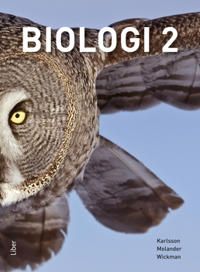Biologi för gymnasieskolan täcker kurs 1 och 2 i biologi. Ett evolutionärt perspektiv präglar innehållet i böckerna. Texterna är resonerande och rika på exempel, så att läsaren lättare förstår biologiska mekanismer. Varje avsnitt inleds med en översikt och avslutas med frågor och en begreppskarta. I slutet av böckerna finns ordförklaringar. Läromedlet är ett utmärkt val för dem som satsar på fortsatta studier i medicin, biologi eller andra naturvetenskapliga ämnen. I serien ingår också lärarhandledningar och onlineböcker.Biologi för gymnasieskolan täcker kurs 1 och 2 i biologi. Ett evolutionärt perspektiv präglar innehållet i böckerna. Texterna är resonerande och rika på exempel, så att läsaren lättare förstår biologiska mekanismer. Varje avsnitt inleds med en översikt och avslutas med frågor och en begreppskarta. I slutet av böckerna finns ordförklaringar. Läromedlet är ett utmärkt val för dem som satsar på fortsatta studier i medicin, biologi eller andra naturvetenskapliga ämnen. I serien ingår också lärarhandledningar och onlineböcker.
Läs mer
Utmärkande drag
- Utförliga texter med möjlighet till både urval och fördjupning
- Inledande översikt i början av varje avsnitt
- Sammanfattningar i form av begreppskartor
Biologi 1
Biologi 1 inleds med ekologi, som sedan naturligt glider över i hållbar utveckling. Cellers byggnad förbereder sedan för Cellens genetik med genteknik och Individens genetik, som lägger grunden för evolutionskapitlet. I kapitlen Etologi och beteendeekologi samt Organismernas släktskap och ekologi utforskas livets mångfald både i beteenden och former. Innehållet är omfattande vilket ger möjlighet till urval och fördjupning. Finns även som Onlinebok.
Biologi 2
I första kapitlet fördjupas teorin om cellen, och det omfattar nu även genteknik. Kapitlet om växter och svampar ger en överblick av dessa organismers anatomi och fysiologi. I det mycket omfattande kapitlet Människans fysiologi beskrivs alla organsystem, men fokus ligger på immunförsvaret och nervsystemet. Livsstil och hälsa betonas också. I kapitlet Livscykler beskrivs hur olika organismer klarar fortplantningen, och i sista kapitlet, som är helt nytt, tas olika aspekter på sex och kärlek upp. Innehållet är omfattande vilket medger urval, fördjupning och breddning. Finns även som Onlinebok.
Lärarhandledningarna
Vi har gemensamma lärarhandledningar till våra två biologiserier. Dessa finns som nedladdningsbara filer och innehåller följande:
- kommentarer till delområdena i kurserna Biologi 1 och Biologi 2.
- teoretiska och praktiska övningar
- laborationer
- mikroskoperingsförslag (bara i lärarhandledningen till Biologi 2)
- svar på frågorna i böckerna
Materialet motsvarar ca 350 A4-sidor i Biologi 1-handledningen och ca 450 A4-sidor i Biologi 2-handledningen.
Om författarna
Per-Olof Wickman är professor i didaktik vid Institutionen för utbildningsvetenskap med inriktning mot matematik och naturvetenskap vid Stockholms universitet. Hans forskning om lärande i naturvetenskapliga ämnen är internationellt uppmärksammad. Blev ordförande i Skolforskningsnämnden 2015.
Biology for secondary school covers courses 1 and 2 in biology. An evolutionary perspective characterizes the content of the books. The texts are reasoned and rich in examples to help the reader understand biological mechanisms. Each section starts with an overview and ends with questions and a concept map. At the end of the books there are glossaries. The textbook is an excellent choice for those pursuing further studies in medicine, biology or other science subjects. The series also includes teacher's guides and online books.Biology for secondary school covers courses 1 and 2 in biology. An evolutionary perspective characterizes the content of the books. The texts are reasoned and rich in examples, making it easier for the reader to understand biological mechanisms. Each section starts with an overview and ends with questions and a concept map. At the end of the books there are glossaries. The textbook is an excellent choice for those pursuing further studies in medicine, biology or other science subjects. The series also includes teacher's guides and online books.
Read more
Distinctive features
- Comprehensive texts with opportunities for both selection and in-depth study
- Introductory overview at the beginning of each section
- Summaries in the form of concept maps
Biology 1
Biology 1 begins with ecology, which then flows naturally into sustainable development. The building of cells then prepares for the genetics of the cell with genetic engineering and the genetics of the individual, which lays the foundation for the evolution chapter. The chapters on Ethology and Behavioural Ecology and Relationships and Ecology of Organisms explore the diversity of life in both behaviours and forms. The content is extensive, allowing for selection and in-depth study. Also available as an online book.
Biology 2
The first chapter expands on the theory of the cell and now includes genetic engineering. The chapter on plants and fungi provides an overview of the anatomy and physiology of these organisms. The very comprehensive chapter on human physiology describes all organ systems, but focuses on the immune and nervous systems. Lifestyle and health are also emphasized. The chapter on Life Cycles describes how different organisms manage reproduction, and the final chapter, which is completely new, deals with different aspects of sex and love. The content is comprehensive, allowing for selection, deepening and broadening. Also available as an online book.
Teacher's guides
We have joint teacher guides for our two biology series. These are available as downloadable files and contain the following:
- comments on the topics of the Biology 1 and Biology 2 courses.
- theoretical and practical exercises
- laboratory exercises
- microscopy suggestions (only in the Biology 2 teacher's guide)
- answers to the questions in the books
The material corresponds to about 350 A4 pages in the Biology 1 guide and about 450 A4 pages in the Biology 2 guide.
About the authors
Per-Olof Wickman is professor of didactics at the Department of Educational Sciences with a focus on mathematics and science at Stockholm University. His research on learning in science subjects is internationally recognized. Became chairman of the School Research Board in 2015.









